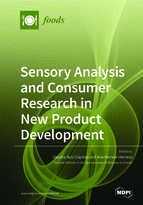Sensory Analysis and Consumer Research in New Product Development
A special issue of Foods (ISSN 2304-8158). This special issue belongs to the section "Sensory and Consumer Sciences".
Deadline for manuscript submissions: closed (25 December 2020) | Viewed by 95193
Special Issue Editors
Interests: meat quality; food safety; animal production; food analysis; meat science; poultry; animal nutrition; food microbiology and safety; food science and technology; food preservation
Special Issues, Collections and Topics in MDPI journals
Interests: development of healthy meat products; vibrational spectroscopic techniques (raman and infrared spectroscopy); textural properties; biogenic amines; food safety; quality indices
Special Issues, Collections and Topics in MDPI journals
Special Issue Information
Dear Colleagues,
Sensory analysis is an essential tool in new product development to evaluate not only the quality but also the potential commercial viability of new foods. There are different types of sensory analysis available, ranging from traditional sensory profiling methods such as Quantitative Descriptive Analysis (QDA) to the more recently developed rapid sensory profiling techniques using non-trained assessors, such as Check All That Apply (CATA), Napping, Flash Profile, Free Sorting, Temporal Dominance of Sensations (TDS), etc., each having their advantages and disadvantages.
Consumer research is also essential, as attitudes, behaviors, and emotions need to be understood and measured to gather insight into the development of successful new products. The study of the context in sensory evaluation is also becoming more important, with the focus shifting from the product to the consumer and virtual reality being used as a tool to bring sensory analysis out of the traditional booths. The field of sensory and consumer research is constantly evolving, and its infiltration of social media and the use of data mining could also provide useful complementary insights for the development of new foods.
This Special Issue encourages authors to submit original research articles or reviews addressing consumer research, advances in sensory analysis techniques (both new and traditional), and the application of both sensory and consumer science in new product development.
Dr. Claudia Ruiz-Capillas
Dr. Ana Herrero Herranz
Guest Editors
Manuscript Submission Information
Manuscripts should be submitted online at www.mdpi.com by registering and logging in to this website. Once you are registered, click here to go to the submission form. Manuscripts can be submitted until the deadline. All submissions that pass pre-check are peer-reviewed. Accepted papers will be published continuously in the journal (as soon as accepted) and will be listed together on the special issue website. Research articles, review articles as well as short communications are invited. For planned papers, a title and short abstract (about 100 words) can be sent to the Editorial Office for announcement on this website.
Submitted manuscripts should not have been published previously, nor be under consideration for publication elsewhere (except conference proceedings papers). All manuscripts are thoroughly refereed through a single-blind peer-review process. A guide for authors and other relevant information for submission of manuscripts is available on the Instructions for Authors page. Foods is an international peer-reviewed open access semimonthly journal published by MDPI.
Please visit the Instructions for Authors page before submitting a manuscript. The Article Processing Charge (APC) for publication in this open access journal is 2900 CHF (Swiss Francs). Submitted papers should be well formatted and use good English. Authors may use MDPI's English editing service prior to publication or during author revisions.
Keywords
- food quality
- sensory properties
- sensory analysis
- rapid sensory profiling techniques
- consumer research
- new product development
- Quantitative Descriptive Analysis (QDA)
- Check All That Apply (CATA)
- Napping
- Flash Profile
- Free Sorting
- Temporal Dominance of Sensations (TDS)







